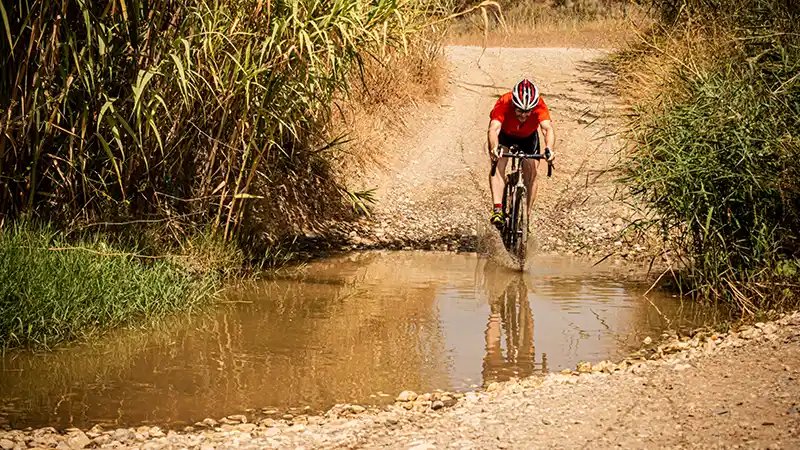For those who enjoy biking on the open road, at some point you will likely come across surfaces other than asphalt.
A question that many riders have is, is riding a road bike on dirt or gravel ok?
The answer to that is, yes, riding a road bike on dirt or gravel surfaces is fine.
In fact, road bikes can pretty much go on any surface including dirt, gravel, and cobblestone (but don’t get all crazy and ride your road bike down a mountain bike trail).
Below we cover 10 tips to assist in your endeavor of riding a road bike on dirt.
Riding a Road Bike On Dirt or Gravel – 10 Tips

1. Remain Calm
Whereas you may feel stable and in control on a flat surface, riding a road bike on dirt or gravel will probably result in some instability.
Odds are you will experience some lateral movement from your front tire as it may slide slightly from side to side, which is totally normal when riding on dirt or gravel.
Keeping calm with your body loose and a normal grip on your handlebars is the best way to maintain control.
When you hit a corner or turn, focus on keeping your body in more of an upright position with your weight over your wheels than you may normally on a paved surface.
2. Speed and Momentum
While in your calm and controlled state, it is important to maintain a pace and momentum that allows your front wheel to ride smoothly over the dirt and gravel surface.
Depending on the roughness of the terrain, you might change to a higher gear to help maintain control and keep your bike stable.
3. Stay Seated
Whether you are hitting an incline or just have the desire to gain more power and speed, it is best to avoid the urge to stand up out of the saddle.
If you shift your body weight too far forward not only will you lose traction in your back wheel, but you will put additional pressure on your front wheel.
This added pressure could not only cause it to slip on the dirt and gravel, but it could also lead to a punctured tire.
4. Easy On The Brakes
As dirt and gravel-packed paths offer less traction than paved roads, it is best to avoid high speeds.
Breaking early will not only help to maintain control of your bike but also keep your tires from wearing out rather than skidding to a stop.
5. Stay In Your Lane
Keep an eye open for previously made lines created by other riders where they have packed down dirt or gravel overtime.
Think of this space as your own little “gutter” as you avoid any loose terrain.
However, if the situation calls for you to evacuate your lane, make sure that you just pedal through it and keep your wheels pointed straight.
6. Practice Makes Perfect
Like any new skill, riding a road bike on dirt or gravel takes practice.
Start with easy terrain and gradually work your way up to more challenging surfaces.
Be patient and keep practicing, and you’ll soon be riding with confidence.
7. Look Ahead and Plan Your Route
When riding a road bike on dirt or gravel, it’s important to keep you eyes looking ahead and plan your route.
This will help you avoid obstacles and maintain control of your bike. Be sure to keep your eyes on the road and always be aware of your surroundings.
8. Lower Tire Pressure
Lowering your tire pressure slightly can help improve your bike traction and reduce the risk of slipping.
However, don’t lower the tire pressure too much, as this will increase the risk of flats and other tire damage.
9. Use a Wider Handlebar
A wider handlebar can help you control your bike and maintain stability on dirt and gravel roads.
Try to find a handlebar that is wider than your current one, but that is comfortable to use.
This will help you maintain a good grip and decrease the risk of slipping.
10. Be Prepared for Emergencies
It’s always important to be prepared for emergencies – even when riding on dirt or gravel.
Carry along a repair kit, that includes a spare tube, tire levers, and a pump.
You will also want to carry a first aid kit and a cell phone – in case of an emergency.
By following the above tips, you can have confidence and more control when riding a road bike on dirt. Remember to always ride safely and pay attention to your surroundings.
Road Bike vs Gravel Bike
While road bikes can handle off-road routes, for those who are constantly riding a road bike on dirt or gravel roads (along with paved roads), a gravel bike may be a better option.
No products found.
Wheels and Tires
The most obvious difference between a road bike and a gravel bike is the size of the tire.
Most modern standard race bikes come equipped with tires ranging from 23-32mm, whereas gravel bikes will have a wider rubber surface ranging from 38-50mm to allow for better grip and handling.
Road bikes come with “slick” tires which means there are no raised knobs on the tire tread, resulting in a smooth-flowing, minimal resistance ride.
Gravel bikes come equipped with a tread that can grip off-road surfaces.
Geometry
To the average person, the difference between a road bike and a gravel bike is minimal as far as the geometry of the bike.
However, the difference between a couple of millimeters or degrees can make a big difference in how your bike handles a riding surface.
As far as the build of each bike, road bikes, which are more aerodynamic, have a shorter wheelbase with steeper angles for faster riding and active handling.
Gravel bikes come with a longer wheelbase and more slack head angle which allows for better stability to allow riders to navigate through more challenging terrain.
Suspension
Unlike mountain bikes, most road bikes do not come factory equipped with shocks as they add weight and make the bike more challenging to control while riding at fast speeds.
They do, however, come equipped with a different type of suspension often found in the carbon fiber framework.
Some bike brands have also dealt with shock absorption by detaching the handlebars and seat post.
Gravel bikes are now available with either integrated suspension options such as frame material, short travel forks, headset springs, and absorbing seat posts or aftermarket components that riders can add as they see fit.
Components
While most components of a road bike and gravel bike are similar, there are a few differences that make a gravel bike a smoother ride on a bumpy route.
Road bikes favor rim brakes which are lighter, whereas gravel bikes come equipped with disc brakes to provide increased power and control in various weather and terrain conditions.
We often find both bikes with 1x and 2x drivetrains with road bikes using a two front chainring option as the transfer between gears is smaller, allowing for a more comfortable cadence regardless of the speed.
Gravel riders often lean towards a single front chainring as while there is a bigger jump between gears it is easier to change and there is less likelihood of dropping chains.
Handlebars and Saddle
Both road bikes and gravel bikes come equipped with the same drop bars, however, there are some minor differences that make a major difference for riders.
The drop bars on road bikes usually have a longer reach and deeper drop allowing for a more aerodynamic position.
They often flare handlebars on gravel bikes with a shorter stem to allow the rider’s hands to be in a broader position for navigating rougher surfaces and loose corners.
Equipment
Other than for a moment or two, a regularly equipped road bike with thin tires and narrow rims will not provide you with a stable ride and proper traction on dirt or any other off-road terrain.
You will also want to consider the weight and measurements of your bike frame as it could be challenging to control on unpaved surfaces.
Tires
No products found.
The standard road bike rides on tires with a minimal tread that are 700c x 23mm to provide low rolling resistance and a smooth ride.
That being said, riding a road bike on dirt or gravel will require some tread pattern and increased tire width. Bumping your tires up to 28mm should provide you with a comfortable ride.
Prepare your travel kit with an extra tube as sharp rocks can easily puncture the traditionally thin, highly pressured road tire.
What To Wear?
No products found.
If you know you will encounter a dirt or gravel path on your route, dress accordingly.
Wearing shorts with premium or extra padding will make for a much more comfortable ride and your nether region, glutes, and lower back will thank you for it later.
As you will spend most of the ride in the saddle to maintain an upright and stable riding position, your glutes will take a bit of a beating.
Having a high-quality endurance chamois will help deal with vibration control, moisture, pressure points, and chafing.
Benefits
While some riders may turn their noses up at the thought of riding a road bike on dirt, it comes with a few benefits.
It allows you to explore alternative routes and areas, making your rides less monotonous.
Not only will it provide new scenery, it will probably expose you to unfamiliar sounds (nature), or lack of street noise, which could be more calming.
Depending on how tightly packed or loose the dirt or gravel is, navigating your road bike on unfamiliar terrain will help enhance your stability, power, and overall handling skills.
